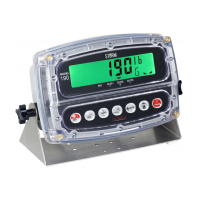Model 190 Installation, Technical and Operation
8400-M022-O1 Rev J
4.6.5 Multi-Point Calibration
This method requires up to four weights, an empty scale and has up to
four conversion factors. This method uses up to five calibration points
(CAL1=, CAL2=, CAL3=, CAL4=, and CAL5=). The five points
correspond to zero weight, up to three midpoint weights, and the test
load or test weight and can be applied in any order. This method can be
used to correct for system nonlinearity.
CAL1= – First Calibration Weight
1. The display will show CAL1=. This is the first of five calibration
weights. This weight could be ZERO (NO LOAD) or the TEST
WEIGHTS (TEST LOAD).
2. Press the TARE key to view the current setting.
3. If the first calibration weight is to be ZERO (NO LOAD), press the
TARE key.
4. If the first calibration weight is to be the TEST WEIGHTS (TEST
LOAD), use the UNITS/ and Fn/ keys to input the value of the
test weights.
5. Place the weights on the scale platform, then press the TARE key.
6. Starting at the left and proceeding right, a series of dashes will
appear on the display.
7. Next, starting at the left and proceeding right, the dashes will
disappear, after which the display will show: CAL2=.
CAL2= – Second Calibration Weight
1. The display will show CAL2=. This is the second of two calibration
weights. This weight could be ZERO (NO LOAD) or the TEST
WEIGHTS (TEST LOAD).
2. Press the TARE key to view the current setting.
3. If the second calibration weight is to be ZERO (NO LOAD), press
the TARE key.
4. If the first calibration weight is to be the TEST WEIGHTS (TEST
LOAD), use the UNITS/ and Fn/ keys to input the value of the
test weights.
5. Place the weights on the scale platform, then press the TARE key.
6. Starting at the left and proceeding right, a series of dashes will
appear on the display.
7. Next, starting at the left and proceeding right, the dashes will
disappear, after which the display will show: CAL3=.

